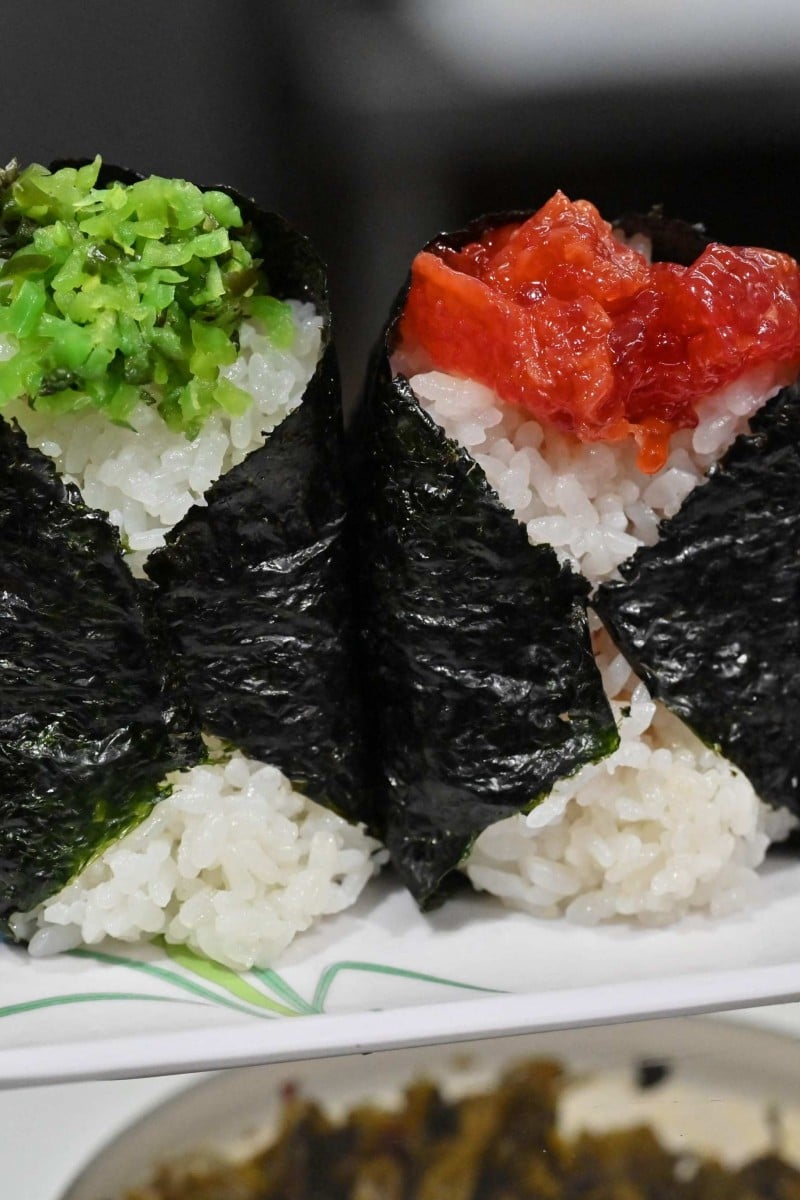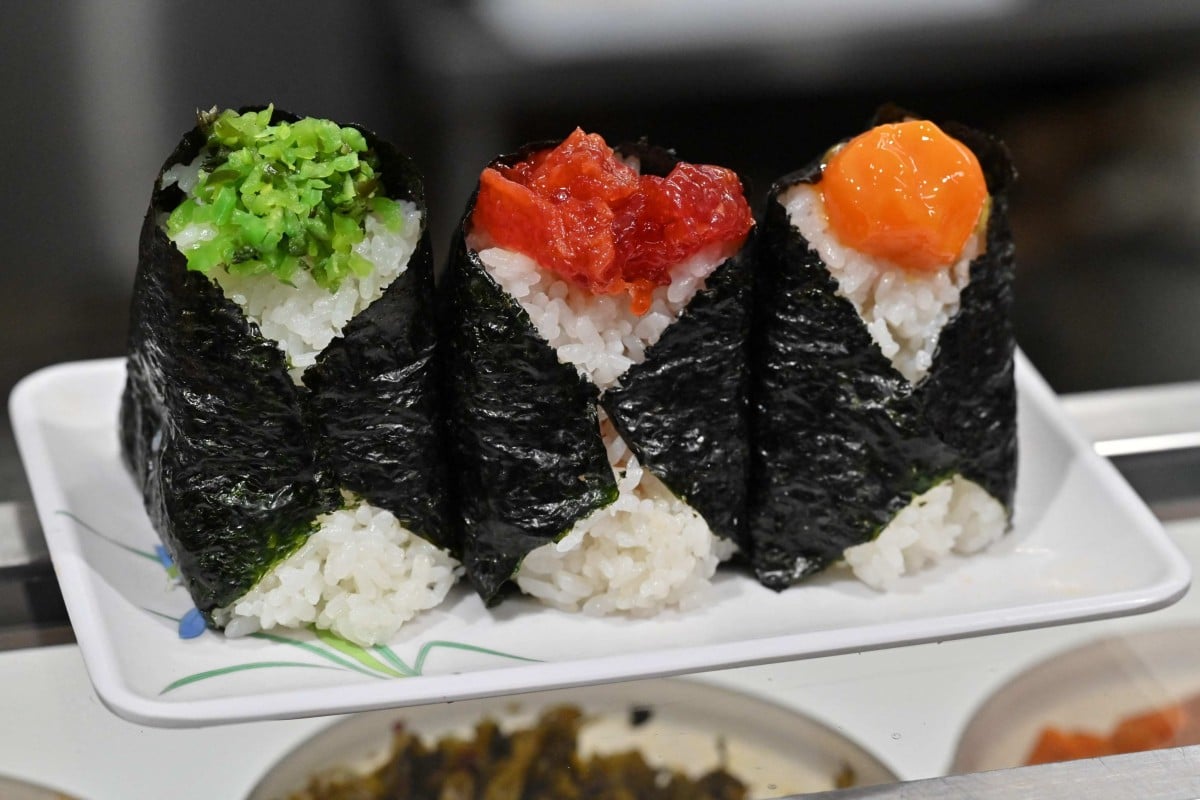
5-minute listening: Popularity of onigiri rice balls is rising in Japan and worldwide
- The stuffed rice balls wrapped in seaweed have long been in demand as on-the-go fuel in the land of the rising sun
- Practise your English with our short listening exercises: play the audio linked below; answer the questions; and check the answers at the bottom of the page
 Wrapped in seaweed and stuffed with delicious fillings, onigiri rice balls are shaking off their reputation as a cheap and uninspiring snack in Japan. Photo: AFP
Wrapped in seaweed and stuffed with delicious fillings, onigiri rice balls are shaking off their reputation as a cheap and uninspiring snack in Japan. Photo: AFPQuestions
1. What is the main ingredient used in traditional onigiri?
A. rice
B. seaweed
C. salmon
D. cucumber
2. If something is “enticing”, it is …
A. new and unusual.
B. sold in many places.
C. not particularly appealing.
D. attractive and interesting.
3. How long has Onigiri Bongo been around?
A. one year
B. slightly less than 30 years
C. more than 50 years
D. 100 years
4. What do the “unusual offerings” at Onigiri Bongo refer to?
A. condiments
B. types of rice
C. fillings
D. none of the above
5. What is the maximum number of people who can dine in at Onigiri Bongo at any
time?
A. eight
B. nine
C. 60
D. The shop is strictly takeaway.
6. What does the phrase “on-the-go fuel” suggest about onigiri?
A. It is a simple yet nutritionally dense food that has been a beloved part of the
Japanese diet for centuries.
B. It has been a staple food in Japan for centuries and is an essential part of the locals’
diet.
C. It is a dish with rich historical context, having been consumed by samurai on
the battlefield.
D. It is a portable food that people can easily eat while they are moving around.
7. Which ready-to-eat food was most popular in Japan in 2022, according to the Japan
Ready-made Meal Association?
A. onigiri
B. cup noodles
C. bento lunchboxes
D. sandwiches
8. What is Onigiri Asakusa Yadoroku known for?
A. opening the first onigiri restaurant abroad
B. being included in the Michelin Guide
C. selling the most expensive onigiri in Japan
D. creating a new type of onigiri filling
9. Which of the following factors have contributed to the rise of specialised onigiri
shops according to the podcast?
A. introduction of premium ingredients in onigiri
B. rising inflation and the desire for cheaper meals
C. increased demand for takeaway meals
D. all of the above
10. Which word can replace “booming” in the podcast?
A. surging
B. deafening
C. thriving
D. experiencing
11. Where are Miyuki Kawarada’s shops located?
A. Kyoto
B. Tokyo
C. Hokkaido
D. outside Japan
12. What do Miyuki Kawarada’s shops specialise in?
A. onigiri made with high-quality ingredients
B. onigiri that is cheap and affordable
C. creative and innovative onigiri fillings
D. vegetarian and vegan onigiri
13. What is Japan’s “best-known culinary export” according to the podcast?
A. miso soup
B. ramen
C. sushi
D. Japanese curry
14. Which word has a similar meaning to “dethrone” in the podcast?
A. overtake
B. downgrade
C. dismiss
D. eject
15. Why might it be easy to adapt onigiri to suit different cultures?
A. Rice balls are common in cultures around the world.
B. This snack is perfect for grabbing on the go.
C. It is easy for anyone to prepare onigiri at home.
D. People can change the fillings to meet their diet or preferences.
Answers
1. A
2. D
3. C
4. C
5. B
6. D
7. C
8. B
9. D
10. A
11. B
12. A
13. C
14. A
15. D
Script
Adapted from Agence France-Presse
Voice 1: Wrapped in seaweed and stuffed with delicious fillings, onigiri rice balls are shaking off their reputation as a cheap snack in Japan – and enticing hungry visitors from abroad. Mouth-watering pictures on social media, rising demand for affordable lunches, and a surge in tourism to Japan are all drawing people to the humble onigiri.
Voice 2: Just ask any of the customers waiting in a quiet corner of Tokyo for the restaurant Onigiri Bongo to open. Some would wait for eight hours, said 71-year-old Yumiko Ukon, who runs the shop that is more than half a century old. Ukon’s team makes 60 different types of onigiri, bulging with traditional fillings like pickled plum or more unusual offerings such as bacon with soy sauce. Onigiri Bongo only has nine counter seats but sells around 1,200 rice balls daily.
Voice 1: The onigiri has long been popular as on-the-go fuel in Japan. People have been eating this dish for over a millennium, and samurai used to take them onto the battlefield. Now, the quick bites can be found in convenience stores on practically every corner of the country. According to the Japan Ready-made Meal Association, in 2022, onigiri rice balls were the second most frequently purchased ready-to-eat food in Japan after bento lunchboxes.
Voice 2: The oldest rice ball restaurant in Tokyo is Onigiri Asakusa Yadoroku, and it was included in the 2019 Michelin Guide, elevating the status of the snack. This changed people’s perception of onigiri from an everyday bite to a quality dish.
Voice 1: The number of specialised onigiri shops is rising quickly. The trend has been driven by demand for takeaway meals during the pandemic, as well as inflation, as people choose onigiri over restaurant meals to save money. Younger customers are also attracted by premium rice balls made with quality ingredients.
Voice 2: With more visitors flocking to Japan and the country’s pop culture booming in popularity, onigiri is also becoming a lunch option overseas. Japanese rice ball chain Omusubi Gonbei has opened outlets in Paris and near Grand Central Station in New York.
Voice 1: Miyuki Kawarada is the president of Taro Tokyo Onigiri, which has two shops in the capital selling top-quality onigiri. Kawarada wants to open onigiri restaurants abroad and thinks the snack could dethrone sushi as Japan’s best-known culinary export. She said that onigiri could be easily adapted to suit different cultures and that she hoped to change people’s stuffy, old-fashioned image of rice.